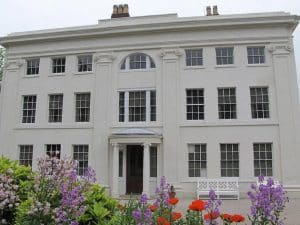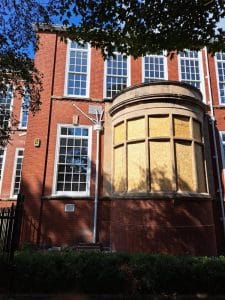Birmingham’s Architectural Tapestry of Wooden Sash and Timber Casement Windows
Unveiling Birmingham’s Architectural Treasures: Timber Windows and Wooden Craftsmanship
Birmingham, a city brimming with industrial heritage and historical significance, holds within its streets a collection of architectural marvels that tell the tale of craftsmanship and elegance. In this blog post, we embark on a journey through Birmingham, in the heart of the Midlands. We place the spotlight on the exquisite artistry of the wooden windows that grace local historic buildings. Both sash and casement windows emerge not just as functional elements but as expressions of wooden art. As we traverse through these architectural treasures, let us appreciate the enduring beauty of timber wood windows that continue to narrate Birmingham’s rich history. Each window, with its intricate woodwork, stands as a testament to the timeless allure of craftsmanship in the heart of England.
The Old Crown: A Tudor Gem in Digbeth
Embarking on our exploration in Digbeth, we delve into the captivating history of The Old Crown, an establishment steeped in the rich tapestry of Tudor architecture and hailed as Birmingham’s oldest pub. The allure of this historical gem lies not only in its age but also in the meticulous details of its timber-framed charm. As we step through its age-worn threshold, our gaze is immediately drawn to the enchanting timber casement windows. Adorned with elaborate wooden mullions and transoms, these windows stand as living testaments to the craftsmanship of a bygone era. The timber frames, weathered by time, echo tales of centuries past, inviting visitors to marvel at the enduring beauty woven into the very fabric of Birmingham’s architectural legacy. It’s in this hallowed space that history breathes, and the intricate woodwork of The Old Crown becomes a tangible connection to the city’s storied past.
Bournville: Tudor Woodwork
Nestled in the quaint charm of Bournville, Birmingham, the allure of timber windows, especially the exquisite casement windows, adds a unique touch to the architectural landscape. Bournville, renowned for its picturesque setting and historic significance, is home to treasures like Selly Manor, a Tudor gem relocated to this idyllic locale. The timber-wood craftsmanship of the casement windows at Selly Manor reflects the dedication to preserving the authenticity of the Tudor era. As you stroll through the serene streets of Bournville, the timber windows stand as a testament to the commitment to architectural heritage, providing a delightful glimpse into the rich history that permeates this charming corner of Birmingham. If you’re a history enthusiast or an admirer of fine craftsmanship, the casement windows in Bournville weave a tale of timeless elegance, harmonising with the scenic beauty that defines this historic neighbourhood where wooden craftsmanship takes centre stage.
Perrott’s Folly: Gothic Splendour in Edgbaston
Edgbaston, a district known for its elegant Victorian and Edwardian architecture, boasts a splendid array of timber wood windows and sash windows that contribute to the area’s timeless charm. As you stroll through the leafy avenues of Edgbaston, the architectural heritage becomes apparent in the Gothic splendour of Perrott’s Folly. This iconic tower, gracing Birmingham’s skyline, features sash windows adorned with intricate timber wood detailing, offering a unique glimpse into the craftsmanship of a bygone era.
Edgbaston’s residential streets also showcase a variety of Victorian and Edwardian homes, each adorned with its own distinctive timber and wood windows. The meticulous design of sash windows in these residences reflects the attention to detail that characterises the architectural aesthetics of Edgbaston. The combination of timber’s warmth and the classic elegance of sash windows contributes to the overall character of the district, creating a harmonious blend of tradition and sophistication.
Whether you find yourself exploring the historical landmarks or wandering through the residential enclaves, Edgbaston’s timber wood windows and sash windows tell a captivating story of craftsmanship and architectural finesse. These windows, with their timeless appeal, are not merely functional elements but integral components that contribute to Edgbaston’s status as one of Birmingham’s most distinguished and visually appealing districts.
The Council House: Neo-Baroque Elegance Unveiled

Standing as the epitome of neo-Baroque grandeur, the Council House emerges as a dazzling showcase of Birmingham’s architectural prowess. This architectural masterpiece, with its imposing facade and intricate detailing, beckons admirers into a world of refined elegance. The sash windows, true works of art, captivate the observer with an intricate dance of wooden embellishments that echo the precision and artistry characteristic of the neo-Baroque era. As you approach the Council House, take a moment to appreciate the meticulous craftsmanship displayed in every wooden detail, from ornate mouldings to delicately carved motifs. The windows themselves become portals to history, inviting you to step into the heart of Birmingham’s civic narrative. Beyond being mere architectural features, these windows serve as guardians of a bygone era, where wooden elegance was a testament to the city’s commitment to beauty and sophistication. Marvelling at the Council House’s wooden windows is not just an observation; it’s a journey into the refined intricacies that define the soul of Birmingham’s civic history.
Back to Backs: Industrial Revolution Craftsmanship
Embark on a journey through the living history of Birmingham’s industrial era as you explore the National Trust-managed Back to Backs, located on Hurst Street and Inge Street. Preserving the authentic essence of working-class homes from the 19th century, these remarkable dwellings offer a detailed glimpse into the city’s rich industrial heritage. Instead of the commonly associated sash windows, the Back to Backs feature casement windows, each set within wooden frames that stand as testaments to the craftsmanship of the Industrial Revolution.
Wander through the narrow passageways and ascend the creaking staircases of these unique homes. Take a moment to marvel at the intricacies of the casement windows, observing the variations in design, sizes, and arrangements of panes. The woodwork, weathered by time and infused with resilience, becomes a poignant narrative of the individuals who once inhabited these houses. As you explore, you’ll witness the subtle nuances in craftsmanship that tell the stories of Birmingham’s industrious past, where every wooden element becomes a brushstroke on the living canvas of the Back to Backs. Hurst Street and Inge Street thus become not just locations but portals to a bygone era, where the echoes of the Industrial Revolution resonate through the meticulously preserved architecture of these historical gems.
Soho House: Georgian Finesse Preserved

Soho House, the erstwhile residence of the influential industrialist Matthew Boulton, unveils a captivating panorama of Georgian finesse impeccably preserved within its walls. As you step into the storied corridors of Soho House, the magnificence of its wooden sash windows becomes a focal point, drawing attention to the meticulous craftsmanship of a bygone era. The intricate detailing on the wooden frames, from delicate mullions to ornate transoms, stands as a testament to the skilled artisans who contributed to the construction of this historical gem.
Venturing deeper into the house provides a nuanced exploration of the fusion between functionality and artistry within the Georgian wooden sash windows. The play of natural light through these windows not only illuminates the interiors but also creates a symphony of shadows that dances across the historic rooms. Every corner of Soho House breathes life into the Georgian aesthetic, and the wooden windows play a pivotal role in preserving the authenticity of the architectural design.
The immersive experience within Soho House allows visitors to appreciate the tangible connection between the past and present. Standing within the rooms that once bore witness to pivotal moments in Birmingham’s history, one cannot help but marvel at the enduring legacy encapsulated in the wooden sash windows. Soho House invites enthusiasts and curious minds alike to indulge in the rich narrative of Birmingham’s past, as told through the detailed craftsmanship and preserved Georgian elegance embedded in each pane of these remarkable windows of this historical gem.
Our exploration of Birmingham’s architectural treasures has showcased the enduring beauty of the timber-wood craftsmanship of sash windows and casement windows. From the Tudor charm of The Old Crown to the Gothic splendour of Perrott’s Folly, each historical gem in Birmingham boasts sash and casement windows as wooden masterpieces, contributing to the city’s rich architectural heritage.
These timber wood windows, steeped in history and artistry, transcend time, narrating tales of Tudor, Jacobean, and Georgian eras. The Back to Backs offer a glimpse into the Industrial Revolution, where casement windows stand as silent witnesses to Birmingham’s industrial prowess. The Council House, a neo-Baroque masterpiece, showcases sash windows adorned with intricate wooden detailing, adding a touch of elegance to the city’s civic history.
So, whether you’re an enthusiast of historical charm or a connoisseur of fine craftsmanship, the sash windows of Birmingham beckon, inviting you to appreciate the timeless elegance etched in timber wood, shaping the city’s architectural legacy.
Restoration and Renovation: Our Contribution to the King Edward VI Handsworth School Project in Birmingham
At Ventrolla, we take immense pride in our commitment to preserving architectural heritage, and our recent involvement in the restoration project at King Edward VI, Handsworth School in Birmingham stands as a testament to this passion. The journey to revitalise this historical gem has been both challenging and rewarding, and we are excited to share our contribution with you.


Ventrolla at King Edward VI Handsworth School:
The King Edward VI Handsworth School project presented a unique set of challenges, from preserving intricate architectural details to ensuring the building meets modern standards. Our skilled team at Ventrolla embraced this opportunity with dedication and expertise.
- Preserving Heritage: Our primary focus was on preserving the rich heritage of King Edward VI Handsworth School. We meticulously worked on restoring original features, ensuring that the school retained its historical charm while meeting contemporary needs. From intricate woodwork to classic window designs, every detail was handled with the utmost care.
- Energy Efficiency and Sustainability: In addition to preserving the past, we also incorporated modern elements to enhance the school’s functionality. Our commitment to sustainability led us to integrate energy-efficient solutions, ensuring a harmonious blend of tradition and innovation. The result is a school that not only honours its history but also looks towards a sustainable future.
- Enhancing Learning Spaces: Recognising the importance of a conducive learning environment, we carefully reimagined and optimised classroom spaces. Our goal was to provide students and educators with a comfortable, inspiring atmosphere while maintaining the unique character of the school.
Click the link to find out more about our journey with King Edward VI Handsworth School: King Edward VI (KEVI), Handsworth School, Birmingham – Ventrolla
